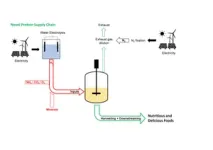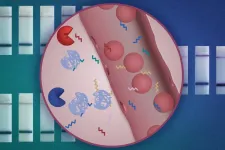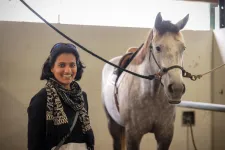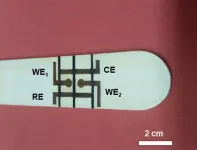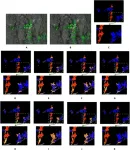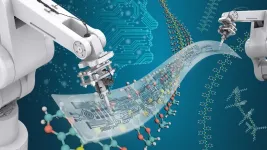(Press-News.org)
Lutz Grossmann is on a scientific mission to create tasty, animal-free protein that has a low carbon footprint and is produced without relying on agricultural land – a usual and progressively stressed source of the global food supply.
“The increasing global population and a changing climate increase the pressure on our food and protein supply coming from these natural habitats,” says Grossmann, an assistant professor of food science at the University of Massachusetts Amherst.
“By 2050, we need to produce up to 60% more food, but we don’t want to transform more land into agricultural land. This is the reason why alternative sustainable protein supply chains are urgently needed to ensure future food security.”
To kickstart his long-term mission as an early-career researcher, Grossmann has been awarded a $430,485 New Innovator Grant from the Foundation for Food & Agriculture Research. “We want to prove that humanity is exceptionally resilient when it comes to food production,” he says.
Grossmann is one of 10 researchers to receive the latest round of New Innovator Grants.
“…FFAR is proud to support these early career scientists as they pursue the creative research that will overcome current and future challenges to our agricultural and food systems,” FFAR executive director Saharah Moon Chapotin said in announcing the grant recipients on April 24.
In a nutshell, the Grossmann Lab’s ultimate goal is to try to make protein-rich foods from a bacteria, powered by hydrogen. “We found this interesting technique where you can use gasses to grow bacteria rich in proteins you can later consume,” he explains.
Grossmann plans to use renewable “green electricity” – solar, hydropower or wind – to split water into hydrogen and oxygen – the process of electrolysis – and then use the hydrogen as an energy source for the bacteria, known as hydrogenotrophs.
“The cultivation of these bacteria requires no inputs coming from traditional agriculture,” Grossmann says. “In fact, the bacteria can be grown by bubbling hydrogen, CO2, and O2 in a reactor filled with water that is enriched with nitrogen and minerals.”
In the 1960s, NASA explored the possibility of using hydrogenotrophic bacteria to feed astronauts on space missions. In recent years, the idea has resurfaced in light of the need for alternative and sustainable global food sources.
Grossmann’s past research focused on cultivating other single-cell proteins – from microalgae – using sunlight, carbon dioxide and fertilizer. “Microalgae is still a very interesting biomass,” he says, “but they need a lot of sunlight and for this you need a lot of surface area, so there are some limitations.”
Once Grossmann and his team grow the bacteria, they will focus on the resulting protein-rich byproducts – a sort of cell slurry. “We have to figure out how to extract the protein and optimize the process to preserve the functionality of the proteins. Then we need to understand what kind of foods we can form,” Grossmann says.
For that, he will have a lot of support. Forming sustainable, alternative, plant-based protein is a primary focus of UMass food scientists, many of whom specialize in the complex, multidisciplinary realm of structural design, nanotechnology, protein functionality, bioavailability and metabolism. “We have to be able to design foods that are nutritious and tasty,” Grossmann says. “In the end, we want to feed people.”
END
CAMBRIDGE, MA — MIT engineers have designed a new nanoparticle sensor that could enable early diagnosis of cancer with a simple urine test. The sensors, which can detect many different cancerous proteins, could also be used to distinguish the type of a tumor or how it is responding to treatment.
The nanoparticles are designed so that when they encounter a tumor, they shed short sequences of DNA that are excreted in the urine. Analyzing these DNA “barcodes” can reveal distinguishing features of a particular patient’s tumor. The researchers designed their test so that it can be performed using a strip of paper, ...
99% of the world's population breathes air that exceeds the limits recommended by the World Health Organization (WHO). This scenario is exacerbated in urban areas where more than 50% of the world's population is concentrated. To mitigate the problem of air pollution, considered by the WHO to be the main environmental risk factor for health worldwide, it is crucial to have more reliable and accurate data on the concentration of air pollutants in our cities, especially nitrogen dioxide (NO2) because of its harmful effects on ...
Humans and horses have enjoyed a strong working relationship for nearly 10,000 years — a partnership that transformed how food was produced, people were transported and even how wars were fought and won. Today, we look to horses for companionship, recreation and as teammates in competitive activities like racing, dressage and showing.
Can these age-old interactions between people and their horses teach us something about building robots designed to improve our lives? Researchers with the University of Florida say yes.
“There are no fundamental guiding principles ...
Doctors often use tongue depressors when peering in a patient’s mouth and throat. But what if that flat wooden spatula could actively evaluate the patient’s health? That’s the premise of an ecofriendly disposable sensor, reported in ACS’ Analytical Chemistry, that can check levels of glucose and other biomarkers in saliva. Researchers say the easy-to-produce device could someday help doctors assess a range of conditions.
Wood is a renewable, biodegradable, natural material that is widely available at low cost, which makes it attractive for researchers who design electronics and sensors. However, this is challenging because the material isn’t good ...
WHAT:
Children with multisystem inflammatory syndrome (MIS-C)—a rare condition linked with the virus that causes COVID-19—have biochemical indicators of cell injury and cell death that are distinct from other children with COVID-19, according to a study funded by the National Institutes of Health. Using high speed, artificial intelligence-controlled molecular sequencing of blood-and-plasma RNA and plasma DNA, researchers found that children with MIS-C have biomarkers indicating damage to multiple organs, the lining of blood vessels and the nervous system. MIS-C usually occurs two to six weeks after ...
LA JOLLA, CALIF. April 25, 2023 - With the help of a new grant from the U.S. Department of Defense for more than $1.7 million, Associate Professor Charles Spruck, Ph.D., will advance an innovative therapeutic approach for metastatic prostate cancer. Known as viral mimicry, the approach tricks the body into thinking that it has a viral infection, stimulating an immune response that can help the body fight cancer.
“In viral mimicry, the body thinks there’s an infection, which kicks the ...
Effective weed control is crucial in agriculture to ensure high crop productivity. It entails the careful separation of weeds from crops before herbicides are sprayed in the fields. In simple terms, the goal of weed control is to remove the weeds while ensuring that the crop are not harmed. Traditional weed control methods have several drawbacks, such as crop contamination, herbicide waste, and poor accuracy. Therefore, it is essential to develop methods that can precisely locate and identify the boundary between a crop and weed and implement ...
Researchers have a new scientific tool called Polybot, combining the power of artificial intelligence with robotics. Potential applications include speeding up the discovery of wearable biomedical devices, materials for better batteries and more.
Today’s wearable technologies like smart glasses and watches are just the start. The next generation of flexible electronics will be more efficient and sustainable, better able to monitor our health and treat certain diseases, and much more. They will be composed of electronic polymer materials — a soft pliable substance that can conduct electricity.
“Just imagine the next generation of polymer ...
New York (April 25, 2022) — The American Geriatrics Society (AGS) today announced Shelley R. McDonald, DO, PhD, MCG, as 2023 Clinician of the Year. Dr. McDonald, who is an Associate Professor of Internal Medicine at Duke University School of Medicine, will be honored at the 2023 AGS Annual Scientific Meeting (#AGS23) being held in Long Beach, CA, from May 4-6 (preconference day is May 3).
“Our 2023 Clinician of the year, Dr. Shelley McDonald, is a national champion for improved perioperative care of older adults undergoing surgery,” said ...
NEW YORK, April 25, 2023 ‒ Aetion®, the global leader in real-world evidence (RWE) technology and analytics, is pleased to announce the culmination of the RCT-DUPLICATE demonstration project, with complete findings published today in The Journal of the American Medical Association (JAMA). This three-year initiative tested whether researchers asking clinical questions in real-world data (RWD) — data from patients’ day-to-day interactions with the healthcare system — would obtain similar results to findings from randomized clinical trials (RCTs). In cases where clinical trial designs aligned with real patient care processes, the RWE studies and RCTs came ...

